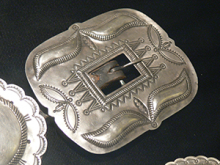Article
Although many indigenous groups in the U.S. Southwest are considered master jewelry makers and silversmiths, with unique designs and methods to their credit, silversmithing did not become a skilled trade in these communities until after European contact in the region occurred. The Navajo, for example, first obtained silver ornaments by trading with the Plains Indians, who had received it from German settlers, and also from the indigenous, Spanish, and later Mexican, further south. It was not until after the 1860s and the war on the Navajo, which culminated in the Long Walk to Bosque Redondo, that Navajo took up silversmithing as their own trade, extracting the silver from U.S. coins. They quickly incorporated turquoise, abundant in the southwest and already used for many purpose, into their work. For Navajo singers and medicine men, medicine bundles and pouches were often decorated with silver, along with fringe and turquoise.
"Silver Navajo belt buckle," photograph by Wolgang Sauber is licensed under CC BY-SA.
Manuscripts
A01 The Blessing Way (01-07) p. 40
A01 The Blessing Way (01-07) p. 43
A01 The Blessing Way (01-07) p. 52
A01 The Blessing Way (01-07) p. 78
A01 The Blessing Way (01-07) p. 100
A01 The Blessing Way (01-07) p. 123
A01 The Blessing Way (01-07) p. 168
A01 The Blessing Way (01-07) p. 226
A06 People of Darkness (03-06) p. 26
A06 People of Darkness (03-06) p. 29
A06 People of Darkness (03-06) p. 42
A06 People of Darkness (03-06) p. 74
A06 People of Darkness (03-06) p. 107
A06 People of Darkness (03-06) p. 199
A06 People of Darkness (03-06) p. 233
A06 People of Darkness (03-06) p. 256
References
Baxter, Paula and Allison Bird-Romero
2014 Medicine Bundle. The American Mosaic: The American Indian Experience.
http://americanindian2.abc-clio.com/Search/Display/1389059?terms=silver…, accessed
June 26, 2014.
Falkenstein-Doyle, Cheri.
2006 The First Phase: Early Navajo Textiles and Silver. Ornament 29 (5): 36-9.
Frisbie, Charlotte J.
1987 Navajo Medicine Bundles or Jish: Acquisition, Transmission, and Disposition in the
Past and Present. Albuquerque: University of New Mexico Press.
Woodward, Arthur
1971 Navajo Silver. A Brief History of Navajo Silversmithing. Flagstaff: Northland Press.

